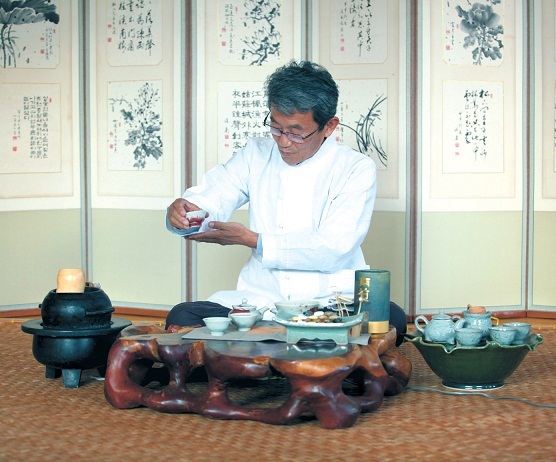For pairing with dried persimmons, Kim recommends jakseolcha as a reasonably-priced match. Harvested when still tender, after ujeoncha during the same period as “sejak” tea, the leaves of jakseolcha are believed to resemble the shape of a sparrow’s tongue.
Kim suggests pairing jookro with songpyeon (filled rice cakes served during Chuseok). Jookro, according to Kim, is made from leaves that have been raised on the dew of bamboo and harvested in mid-May.
For meat and jeon (Korean pancakes), Sejak tea ― which is harvested and made after Ujeon ― is a recommended accompaniment.
‘Haap’-style tteok galbi Owner-chef Sin Yong-il of tteok cafe Haap says tteok galbi is a good way to use up leftover chestnuts, jujubes and meat from Chuseok. Even if the peeled, raw chestnuts served during the holiday have browned a bit, it is okay, says Sin, because everything gets minced and mixed together and spiced up with some tasty seasonings.
Ingredients for tteok galbi: - 400 g beef from the ribs (or any kind of leftover beef)
― 25 g Asian pear juice
― 4 finely chopped chestnuts
― 4 finely chopped jujubes
― 5 g sticky rice powder
― Tteok for the center
Ingredients for seasoning:― 2 tbsp soy sauce
― 1 tbsp finely chopped garlic
― 2 tbsp finely chopped green onions
― 2 tbsp sugar
― Honey to coat the tteok galbi
Directions:
1. Finely chop the chestnuts and jujubes.
2. Prepare the Asian pear juice.
3. Make the seasoning by finely chopping the garlic and green onions and mixing it with soy sauce and sugar.
4. Trim about 80 percent of the fat off the rib meat and mince.
5. Mix together with seasoning sauce, kneading it like dough.
6. Make globe-shaped patties, putting nubs of rice cake in the center and then molding it over, ideally so that the tteok sticks out of the side of each patty a little bit; 400 grams should make approximately 8 patties.
7. Coat each patty with a little bit of honey.
8. First cook the outside of the patties over medium heat in a frying pan before transferring to the oven and baking at 170 degrees Celsius for about 7 to 8 minutes, adjusting as needed depending on the size of the patties.
9. Coat patties in remaining honey and serve.
Pine mushroom rice in stone pot
Lotte Hotel Seoul’s Korean restaurant Mugunghwa serves up rice cooked in stone pot, topped with fragrant slices of the autumnal delicacy ― pine mushrooms. The rice is paired with a special pine mushroom soy-based sauce that is meant to be mixed in with the rice and enjoyed.
Ingredients for the pine mushroom rice:― 200 g soaked white rice
― 170 g water
― 2 g pine nuts
― 4 g peeled gingko biloba nuts
― 5 g cleaned pine mushrooms
― A little sesame seed oil
Directions:
1. First make the pine mushroom sauce by mixing four parts water to two parts soy sauce and one part sugar. Ratio-wise, you will need one stalk of large green onion, one peeled onion and black pepper to taste for approximately three liters of the sauce (should you choose to make that much). Bring all ingredients to boil in a pot and then lower to medium heat and let cook for about five minutes. After the sauce cools, strain out the onion and green onion, and add finely chopped stems of pine mushrooms. Allow the sauce to pickle for a day in the refrigerator.
2. Put all ingredients for the pine mushroom rice, except for the pine mushrooms, in a stone pot and then boil at high heat for 12 minutes. Then cook at low heat for five more minutes. Turn off heat, add chopped pine mushrooms, close lid again and let the mushrooms steam for an additional five minutes.
How to pick prepare pine mushrooms:
Mugunghwa chef de cuisine Chun Duk-sang provides tips on selecting and washing pine mushrooms.
Chun recommends looking for mushrooms with small, closed caps, a sign that it has retained its moisture, he says.
When prepping the mushrooms, Chun says to gently trim off the outside of the lower two-thirds of the stalk, which have been in the dirt, and then to chop off a bit of the bottom of the stem. Then he says to take a kitchen towel and gently wipe the top of the mushroom and the remaining upper, untrimmed part of the stem. Finally, rinse the pine mushroom lightly in running water.
Details
Haap, which opened a new cafe near the Grand Hyatt Seoul in Itaewon-dong, is selling boxed tteok. Owner-chef Sin Yong-il says tteok packaged in boxes made with wood from the royal foxglove are popular Chuseok gifts. A new addition to the menu is injeolmi, which Sin makes super-soft, then cuts and coats it in various flavors to order.
Haap Namsan Cafe; 2F, 231-36 Itaewon-dong, Yongsan-gu, Seoul; (070) 7532-4819; www.haap01.com; open noon to 9 p.m. daily (call in advance)
Mugunghwa will be open during Chuseok and is currently serving special pine mushroom dishes.
Mugunghwa; 38F, Lotte Hotel Seoul, 30, Eulji-ro, Jung-gu, Seoul; (02) 317-7061; open 11:30 a.m. to 2:30 p.m., 6 p.m. to 10 p.m. daily
By Jean Oh (
oh_jean@heraldcorp.com)








